Our regular clients asked me to organize an interesting and unusual fishing and supplement it with hunting. When choosing a country for this trip, I’d been analyzing possible options and as these clients had been to different countries with us before and the dates of our trips had always been rigidly defined, I decided to go to Bolivia this time.
We would like to tell you about our fishing for Chinook in Chile in March 11-19, 2018. For the next season we have already booked the 2 peak weeks in the same lodge: March 10-18 and March 19-27. The groups will be created in the nearest future. Join us!
The river we were fishing in is extremely hard-to-reach for other anglers as it is remote from civilization and there is a large number of shallows which are impossible to pass on low water for any vessel suitable for a group of anglers. A flight by a private plane and a three-hour trip by boat equipped with a 300-horsepower outboard motor (with the average speed of 70km per hour) allowed us to get to the places where time stopped, and where we could not find a single settlement for many kilometers around.
We were fishing in a lodge located on a small island in the Coiba Island neighborhood on the west coast of Panama. At present, Coiba Marine Reserve with the total area of 270 125 hectares is the third largest marine reserve in the world, after a large coral reef in Australia and the Galapagos Islands. The Park is comprised of Coiba Island, 38 small islands and the surrounding waters in the Gulf of Chiriqui. Judging by our own experience, fishing in these places is extraordinary diverse because of the variety of species and fishing spots.
A group of our regular clients from Ukhta (Russia) had been to Brazil a few times before, they had been fishing for various fish species including the peacock bass and payara here. But this time, the guys asked us to arrange a special fishing for arapaima to enrich their collections by this unique trophy. For this tour I had chosen one of the few places on the planet where we could efficiently fish in the wild nature of Amazonia living quite comfortably. As a result, we had a total of 15 arapaima after 4 ½ days of fishing.
For 2 days a comfortable boat became our home and we went to the farthest points located about 100 miles away from the shore. Our farthest points are the tops of seamounts where we have special attractors which are some kind of shelters for small tuna. Such a fodder base created due to the abundance of tuna retains pelagic predators, marlins and sharks, in particular. We had a total of 12 marlins, 10 sharks, and 1 dorado.
Fishing for the tigerfish in the Selous Reserve, the largest protected faunal reserve in Africa, is a unique experience in itself. While being in Selous we met no people, the only exception was the staff of our camp. We managed to combine fishing with recreation in Zanzibar and the acquaintance with the wild nature of Tanzania. This tour can’t be compared to any standard tourist program, and as far as the level of comfort is concerned, this tour is quite suitable even for children. We were able to find locations free not only from malaria, but mosquitoes in general!
Following up on my recommendation, a group of enthusiastic anglers visited Alaska to fish in various rivers and the ocean. After the meeting in Anchorage we went by a private plane to a comfortable lodge where everything was perfect: the location, the guides, the rich fleet of boats and planes, the excellent accommodation, and the perfect cook which is the rarest thing of all. The most prestigious trophy in the fresh waters of Alaska is the Chinook salmon or “king salmon” as the locals call it. To catch this prestigious trophy for a spinning rod is not difficult at all here, and all the adherents of this technique showed excellent results.
Here is the follow-up report on Alaska fishing taken place in June, 2017. After a successful sea fishing we went for the Chinook salmon to the west of Alaska. The sunny weather and positive attitude of all the members of our team created a good mood which accompanied us throughout the whole trip. There were 8 anglers and 2 guides in our team, and each of us wanted to realize his highest fishing expectations during this trip, and first of all, for the Chinook salmon. We chose the beginning of the season for the tour, as it is the optimum period to catch really trophy fish.
Here is our report on the unique fishing for prehistoric fish which can reach an incredible size. Before going fishing to Alaska, a friendly company of 4 experienced anglers decided to follow our advice and go fishing for the alligator gar to Texas. The strikes did not keep us waiting! And in about two hours each of us got a nice trophy. Our anglers managed to adjust to this specific fishing immediately. The guys were waiting patiently for the ancient monster to swallow the bait properly in order to strike the fish for sure. The mouth of this unique fish is arranged so that, while the hook passes through, there is nothing for it to cling to, till it reaches the esophagus.
The population of the “king salmon” is not so numerous in Chile, comparing to Alaska, where our clients can observe the mass migration of the Chinook to spawn every year. The main peculiarity of fishing for Chinook in Chile is the longer freshwater migration route. In Alaska or Kamchatka the fish is migrating to spawn within 3-4 weeks with the peak of 10-14 days, whereas in Chilean Patagonia entering some rivers can continue up to 2.5-3 months. The concentration of the fish here is not so great.
In the morning we went by a small private plane to Lake Strobel or “Jurassic Lake” as it is often called. On the way we had a chance to enjoy truly cosmic landscapes of the south of Patagonia. It is here that the largest rainbow trout in the world can reach the incredible 12 kilos! The lake is densely populated with small crustaceans resembling shrimps and due to this the population of the rainbow trout is so great and rich in trophy specimens. We got settled in a comfortable lodge, had excellent Argentine meat for lunch and went fishing.
Many of you have certainly heard something about arapaima and even thought about getting this incredible trophy. In my opinion, to catch arapaima or pirarucu, as it is often called in Brazil, in the wild nature is the greatest achievement for any angler living on the planet. In February, 2016 a group of anglers went to Guyana to catch this prehistoric monster and other exotic trophies.





































